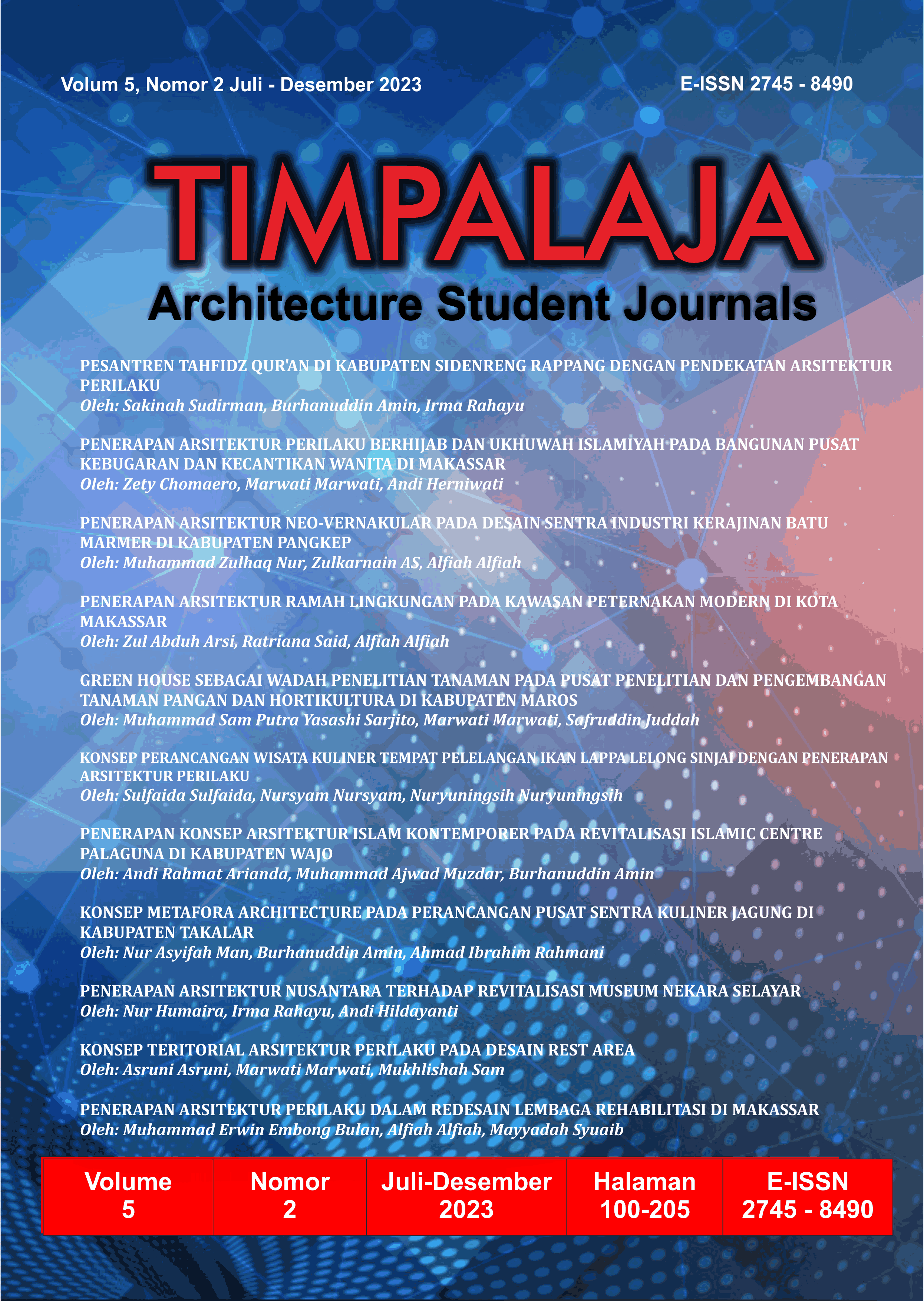Penerapan Arsitektur Nusantara Terhadap Revitalisasi Museum Nekara Selayar
Abstract
Archipelago architecture is a form of architecture that expresses the inseparable unity between humans and their natural environment, reflecting the interconnection of two eras. The Nekara Museum in Selayar Islands Regency has many historical relics that need to be known and recognized by the wider community. The current problem is the revitalization of the Nekara Selayar Museum with an Indonesian architectural approach. The aim is to get a unique Nakara Museum design with an Indonesian architectural approach concept. Data collection methods are through field surveys, literature studies in the form of theoretical/standardized data collection related to functions or approaches, design principles, and precedent studies. Meanwhile, the data analysis method uses descriptive, synthesis, and exploration methods for the results of the design concept. The results of this research are that the location that will be used as a design plan is in Matalalang, Bontobangun District, which is by the RTRW, and the designation of the museum building, namely the design for the revitalization of the Selayar Islands Nekara Museum. Regency, by using an archipelago architectural approach can be a forum for providing information, collecting, caring for, presenting, and preserving cultural products found in the Selayar Islands Regency, both historical relics of its own discovery and government discoveries. This museum was designed with an Indonesian architectural approach.
References
BPS Kabupaten Kepulauan Selayar. (2022). Kabupaten Kepulauan Selayar Dalam Angka 2022. 1–357.
Maulana Yusuf A, Nurzengky Ibrahim, & Kurniawati. (2018). Pemanfaatan Museum Sebagai Sumber Belajar Dalam Pembelajaran Sejarah. Visipena Journal, 9(2), 215–235. https://doi.org/10.46244/visipena.v9i2.455
Sulistijowati, M. (2016). Struktur di Arsitektur Nusantara. Temu Ilmiah ILPBI, 19.
Doddy Soedigdo, Ave Harysakti, T. B. U. (2012). Elemen-Elemen Pendorong Kearifan Lokal Pada Arsitektur Nusantara. Jurnal Perspektif Arsitektur, 9(1), 37–47.
Hidayatun, M. I., Prijotomo, J., & Rachmawati, M. (2014). Arsitektur Nusantara Sebagai Dasar Pembentuk Regionalisme Arsitektur Indonesia. Transformasi Nilai-nilai Tradisional dalam Arsitektur Masa Kini, 1, 1.
Laloma, I., Waani, J. O., & Tondobala, L. (2018). Pendekatan Arsitektur Nusantara Pada Desain Objek Kawasan Wisata Pantai Kabupaten Kepulauan Talaud. Jurnal Fraktal, 3(1), 11–20.
Raodah, R. (2012). BALLA LOMPOA DI GOWA (Kajian Arsitektur Tradisional Makassar). Patanjala : Jurnal Penelitian Sejarah dan Budaya, 4(3), 378. https://doi.org/10.30959/patanjala.v4i3.149
Syamsuriadi, S., Astina, I. K., & Susilo, S. (2019). Arsitektur Rumah Balla Lompoa Galesong Suku Makassar sebagai Sumber Materi Geografi Budaya. Jurnal Pendidikan: Teori,cPenelitian, dan Pengembangan, 4(12), 1601. https://doi.org/10.17977/jptpp.v4i12.13063
Adiyanto, J. (2018). Mencari DNA Arsitektur di Nusantara. May, B015–B022. https://doi.org/10.32315/sem.2.b015
Handayani, T. (2020). Pelestarian Arsitektur Museum Sonobudoyo Yogyakarta. ATRIUM Jurnal Arsitektur, 3(1), 45–58. https://doi.org/10.21460/atrium.v3i1.65
Copyright (c) 2023 Nur Humaira, Irma Rahayu, Andi Hildayanti

This work is licensed under a Creative Commons Attribution-ShareAlike 4.0 International License.
By submitting your manuscript to our journal, you are following Copyright and License







